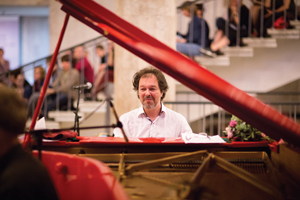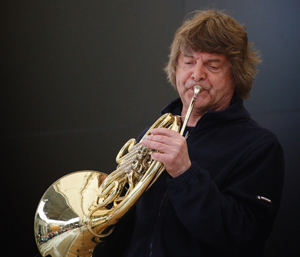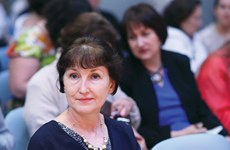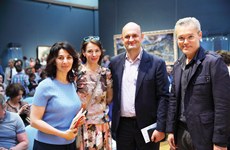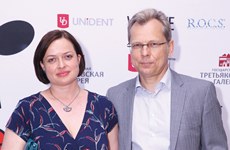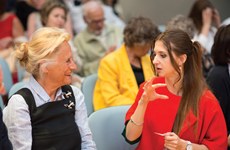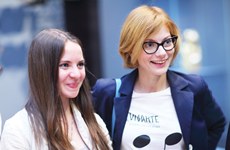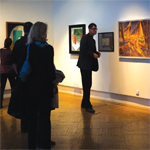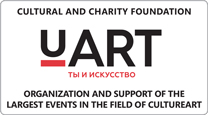The Clouds of Interpretation
Text: Sergei Khachaturov
Photo: Denis Kuznetsov, Evgeny Evtyukhov
 |
The subject of music and art is a most captivating and treacherous one. It entices us with seemingly beautiful parallels and juxtapositions, with the ease of new discoveries. Indeed, we often tend to use musical terms when speaking of art. “What a mellifluous composition!” we exclaim, looking at Watteau’s pastoral scene. And vice versa, when listening to music, our imagination picks up on the trappings of the traditional logocentric schooling, looking for semblances and familiar patterns, and happily paints - pun intended — artful depictions of a sweet scenery or epic celebration.
However, I must admit that projects on the theme of the
convergence of visual art and music are rarely convincing. Each form of art has
its own laws organizing the language of communication and the apparent ease of
transfer, ease of interchangeability is deceptive. Their points of interception
are postulated as reality where understanding of complexity gives way to
consumer perception of common places, reducing the rich and unique language of
Art to banal clichés. There is a far more productive alternative: not to pamper
The ideological platform for this event was the brilliant
VIVACELLO festival created
Another platform of the VIVARTE festival is the “Cello e
Pittura” project which is also supported
 |
|
Each evening Tretyakov Gallery art critics gave a lecture before musical performance |
In the new VIVARTE festival the task has become more
complex. Musicians do not improvise on a theme given to them by the pictures
but create whole programs on a carefully created theme in which the picture is
just one of the inspirations. The great Tretyakov Gallery has become a
participant in its own right. Museum staff assisted in the development of the
theme, but were kept in the dark as to exactly what picture would be presented
at the concert.
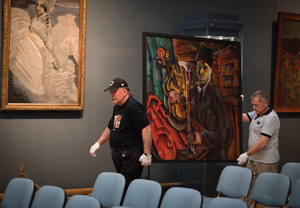 |
|
Each concert was accompanied by a display of an art piece from Tretyakov Gallery’s depository |
One must agree that the link between the portrait of Pavel
Tretyakov by the brush of founder of the “Union of Russian Artists” Nikolai
Dosekina, and the quintet by Antonin Dvorak and the “Memories of Florence”
sextet by Pyotr Tchaikovsky is not obvious. The system of their union refers
more to the territory of social consciousness, reminding us of the general
themes and dedicated internal friendships and intellectual artistic unions of
the end of the 19th and beginning of the 20th Centuries. Cubist Futurist still
life paintings with the violin of Lybov Popova were satellites in which an
enormous alpine horn performed the solo in the opus of the young Richard
Strauss. Outstanding musician Arkady Shilkloper, singer Tatiana Kuindzhi
and pianist Stefan Vladar created a similar sense of mystery, or to use the
terminology of contemporary art: performance.
Thus, this sense of melancholy, thanks to the performative
space of Tretiakov Gallery and the concert they that was chosen to accompany
it, thanks
|
Virtuoso pianist Mikhail Ivanov |
Similarly complicated convergences of different systems of perspective and conditioned the uniqueness of the format and programs of the festival. There were no games of ‘Russian chess’, no dissimulation of music and painting or vice versa. The language of each art form, structured in its own way, has its own morphology, but their interaction, established thanks to today’s outstanding musicians and the masterworks of Russian art of the past, makes it possible to discover new perspectives for understanding the artistic process in its entirety and unity.
And these perspectives substantiate the symposium of
different forms of art for the sake of identifying common systems of
principles. In this regard, the final concert of the festival, a concert
dedicated to the 110th anniversary of the birth of Dmitry Shostakovich, is very
telling. The venue of the concert is the Vrubels Hall. On the easel sits a work
by Pavel Filonov “Shostakovich’s First Symphony”. The “Seven Romances by
Alexander Blok” (soloist Tatiana Kuindzhi) and the arrangement of the 15th
Symphony for violin, cello, piano and percussion by Viktor Derevyanko and Mark
Pekarsky are heard. This new version of the symbolist poetics, the cycle
dedicated to Galina Vishnevskaya, defining perception and unexpectedly
supporting the visual art around it, was broadcast in the space of the Vrubel
Hall. The “Song of Ophelia”, “Gamayun, Bird of Prophecy” wonderfully
complimented the pictures with mythological themes: pictures that were piquant
with exalted,
|
A French horn improvisation by Arkady Shilkloper |
However, music is not art and the time is different.
Dissonance and contrast, tension and release provokes memories of style in
which Shostakovich wrote his cycle: the international modernism and symbolism
that the USSR, to a large extent, also relied on. In painting and sculpture
In his symphony Shostakovich inferred the aesthetic code of
the enormous period of life of all art forms between the 1970s and the 1990s.
The great composer distinctly marked the border between modernism and his
searing lyricism and the rebellious romantic themes

The festival booklet fascinates visitors of all ages |
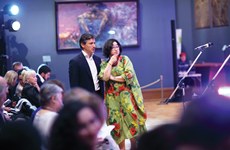
Zelfira Tregulova, Director General of Tretyakov Gallery, and Tamaz Manasherov |
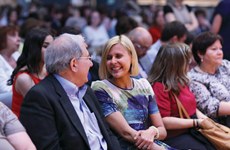
Kristina Zakurdaeva (Skolkovo Foundation) |
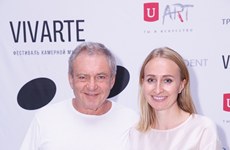
Alexander Golovaty (AORI) and his wife Natalya |
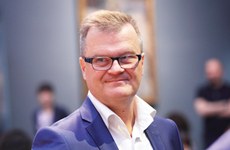
Alexey Abramov, Director of the Institute of Medicine of the Peoples' Friendship University of Russia |
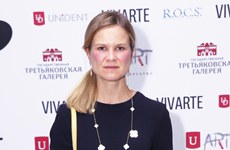
Elena Kaysheva |
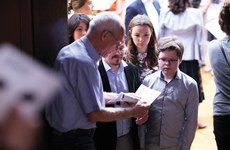
The performance begins in a few minutes |
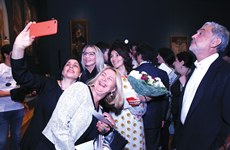
A selfie to remember |

Promenading musically in the Muzeon Park |

Tamaz Manasherov, Olga Sviblova (Multimedia Art Museum, Moscow), and Ekaterina Moiseeva (Bosco di Ciliegi) |
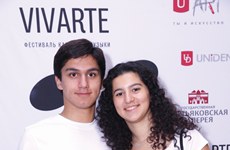
Tony and Dina Manasherov |

The festival's happy extended family |
Back

